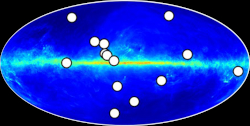 HEAPOW: Introducing the Anti-Stars? (2021 May 24)
HEAPOW: Introducing the Anti-Stars? (2021 May 24)
We live in a material world. As opposed to an anti-material world, i.e. one that's composed primarily of anti-matter. It's a fundamental puzzle why this is, since at the beginning of the Universe, equal amounts of matter and anti-matter should have been produced. It's good for us that the Universe chose sides, since matter and anti-matter annihilate, converting their combined rest mass into radiant energy, when they come into contact. So it's difficult to make things like planets or people in a Unverse that's equal parts matter and anti-matter. We think that the asymmetry between matter and anti-matter was extremely slight, so that, for every billion anti-matter particles, that there was one billion and one particles of matter; from this tiny excess came the structure of the Universe. We've seen only trace amounts of anti-matter currently existing in the Universe, generally produced by high-energy processes around neutron stars or black holes. But could there be bits of anti-matter left behind by the great annihilation of matter and anti-matter just after the Big Bang? A new study using 10 years of data from the Fermi Gamma-Ray Space Telescope has examined the question of whether anti-matter stars, or "anti-stars", could exist in the Universe. An anti-star would be composed of mostly of anti-hydrogen, which, unlike hydrogen, would consist of an anti-proton (a negatively charged proton) orbited by a positron (a positively charged electron). If an anti-star encountered a bit of matter in the space between the stars, the ensuing annihilation would produce gamma-ray emission, potentially detectable by Fermi. The image above shows the map of gamma-ray emission from the entire sky as seen by Fermi over a period of 10 years. The white circles show the location of possible anti-stars, regions of the sky where the gamma rays seen by Fermi could be consistent with gamma rays expected from an anti-star. It's too soon to say, however, whether these sources are really anti-stars or not, and other extreme but more common objects, like "normal" black holes or neutron stars, could account for the gamma-ray emission seen by Fermi. But if they really are anti-stars, it's fun to speculate: could they be orbited by anti-planets populated with anti-people?
IRAP: Are there anti-stars around us? Answer from the Fermi satellite
Constraints on the Antistar Fraction in the Solar System Neighborhood from
the 10-year Fermi Large Area Telescope Gamma-ray Source Catalog ~ Simon Dupourqué et al
- Physical Review D 103(8):3016 (20 Apr 2021) DOI: 10.1103/PhysRevD.103.083016
- arXiv.org > astro-ph > arXiv:2103.10073 > 18 Mar 2021 (v1), 26 Apr 2021 (v3)
| << Previous HEAPOW | High Energy Astrophysics Picture of the Week | Next HEAPOW >> |